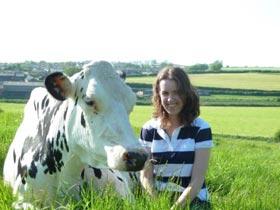
14 minute read
Food & Drink
Food & Drink Modern dairy farm in same family for 90 years
By Karen Bate Sitting on the edge of Sherborne, Castle Farm has been home to the Dimond family for almost 90 years. On this farmland, which stretches through the valley in front of Sherborne Old Castle towards Crackmore Woods, Ian, his wife Dawn and daughter Georgie farm a herd of 140 pedigree Holstein cows in this idyllic setting. In 2011 Ian and Dawn were given the prestigious award of Master Breeder Herd, a rare accolade for high level stockmanship resulting in top quality pedigree cows. Dawn said: “We have recently installed 2 Lely A5 Astronaut ‘robots’ to automatically milk the cows. This amazing technology allows the cows to choose when and how often they want to be milked, thereby giving the cows much more freedom of choice and a relaxed lifestyle. “During the spring and summer months the cows graze the fields around our farm as long as the weather is good! In the winter when it is too wet and cold to be out, they are housed in a large spacious building with comfy cubicle beds and an all-day breakfast buffet!” Dawn added: “All of the cows are cared for on an individual basis. We truly do know our cows, many have their own unique characteristics and personalities. The Health and Welfare of our cows comes before anything else.” The milk is pasteurised on the farm, in the new purpose built pasteurising room through a flow pasteuriser. Although the milk is pasteurised it has not been through the industrial processes of homogenisation and standardisation, meaning it retains all of its wholesome natural flavour and quality and once it has settled, cream will rise to the top. Dawn said: “If you are not keen on this, just give the bottle a shake to mix it back in. We then place it into our
milk vending machine ready to sell directly to you. The milk can be in your fridge within 24 hours of the cows being milked.” The milk vending machine is open Wednesday to Sunday, 8am-6pm. castlefarmdairy@hotmail.com facebook@castlefarmdairy Popeye’s right – there’s so much good in spinach
As the weather has not decided if we are truly entering spring just yet and the evenings still have a chill about them, I have opted for another comforting dish. This time showcasing swede and spinach. Perhaps an unlikely pairing, but one worth trying, I assure you. Spinach has long been renowned as a nutritional powerhouse, historically believed to increase energy and vitality, and improve the quality of the blood. It is well known as a great source of iron, and while plant sources of iron are less efficiently absorbed than meat sources, its absorption is boosted by vitamin C, of which spinach is also a great source. A great example of nature solving a problem, as it so frequently does. Spinach is also a good source of vitamin K, B2, B6, B1, E, carotenes, manganese, and magnesium. Swede is a 34
Rebecca Vincent is a Wincanton nutritionist

good source of vitamins E and C as well as calcium, magnesium, potassium and of course fibre. Swede makes a great mash and is frequently added to stews, but this recipe uses it a little differently. Swede and spinach gratin (serves 4-6) 1 medium swede 100g fresh spinach 300ml pot crème fraiche 60g grated cheese 2 garlic cloves (grated) Few sprigs fresh thyme Pinch of black pepper Heat the oven to 180 and set a small pan on the hob on a medium-low heat. Mix the crème fraiche, cheese, garlic, thyme, and black pepper in the pan and let it gently warm through. Meanwhile peel the swede, cut in half and slice into approximately 1/2 cm thick half circles (easiest on a thick mandolin setting). Wash and dry the spinach. In an oven proof dish, layer the spinach and swede, adding a little of the crème fraiche mix between each. Grate a little cheese over the top and pop in the oven for 20-30 minutes until the swede is soft when tested with a knife or skewer and the top is golden. This is lovely as a side to your Sunday roast or a delicate fish dish. Rebecca Vincent BSc BANT registered nutritionist rebeccavincentnutrition.co.uk
Cooking...
with Mrs Simkins
Old Fashioned Tea Bread
Sometimes you just want to tuck up inside with a hot cup of tea and a nice slice of old fashioned tea bread. Here’s a lovely simple one: there’s no fat in the mix for those wishing to be abstemious, or you can butter it generously in the traditional manner. It’s also good with thin slices of cheese: or it eat on its own as a moist fruit cake. Usually made in a loaf tin, you can also use a round cake tin: cut slices across the cake for buttering or wedges if you are eating as a fruit cake.
Ingredients 400g mixed dried fruit and peel 200ml hot tea (Earl Grey or good old builders’ brew work equally well) 75g soft dark brown sugar 225g plain flour 1½ teaspoons baking powder 1 large egg, beaten Plus Melted butter for finishing, optional
Method Preheat oven to 180C (160C fan oven) gas mark 4 or equivalent. You will need a ½kg (1lb) buttered loaf tin or 20cm (8 inch) round deep cake tin or silicone mould Soak the dried fruit in the tea overnight: keep it covered. Combine the flour and raising agents and sieve half over the mixture. Stir thoroughly into the mix. Add the egg and incorporate it gradually followed by the remaining flour. Stir in the sugar. Ease the mixture into the prepared tin. Smooth the top with the back of a tablespoon dipped in water. Bake for 40 minutes or until a skewer inserted comes out clean: don’t over-bake or it will be too dry. Brush the top with melted butter whilst still warm. And if the sun’s out, you can always take your tea bread into the garden.
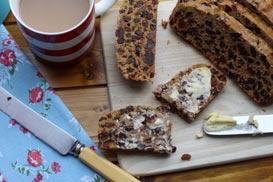

Tip When using silicone moulds always cool completely before turning out.
Check out Mrs Simkins’ website for more recipes: MrsSimkins.co.uk twitter.com/MrsSimkinsCooks email: info@MrsSimkins.co.uk
Mum’s Kitchen...
with Diana Holman
Lemon Drizzle Cake
Ingredients 225g butter, softened 225g caster sugar 4 eggs Finely grated zest of one lemon 225g self-raising flour
Drizzle topping: Juice 1 ½ lemon 85g caster sugar
Preheat oven to 180 or 160 fan oven. Beat butter and sugar until pale and creamy. Beat in eggs a little at a time. Sift in flour, then add zest. Mix until well combined. Spoon into a loaf tin (8x 21cm) lined with non-stick paper and level top o mixture. Bake 45-50 minutes. While cake is cooking, mix lemon juice with sugar to make drizzle. Remove cooked cake, prick all over with a fork and spoon drizzle over cake whilst still hot.
ENFORD FARM SHOP
Home reared Lamb along with locally produced meat, veg, fruit, deli and game. Follow us on Facebook for all of our latest deals and offers including weekly meat pack deals HALF PIG APPROXIMATELY £100 (depending on weight) Open all day, everyday outside shop Fri, Sat Farm shop open 8.30am-5pm Also Arts disiplay Durweston, near Blandford. 01258 450050
Remember pubs? Well, there are
BARRY BROCK takes us on a tour of Sherborne’s old pubs, something we’ve missed doing for some time now...
Margaret Read wrote to The New Blackmore Vale recently to say she was going to search out Sherborne’s old pubs – what a great idea! Pubs have been part of the English way of life for so long and Sherborne used to have so many more pubs –most of them now gone. It is not hard to work out why, as our lives are so different now in these changing times. In the past, men and women would come in from the surrounding villages for the markets and fairs, and coaches bound for Exeter and London would stop off at the inns on the A30, that great western highway. Not much of this happens any more, and travellers and marketgoers seldom have time to stop for a refreshing drink. This is why so many inns and pubs have closed since the Second World War: I can think of the Antelope, Black Horse, Castle, Crown, Digby, Greyhound, Queen’s Head, Swan, New Inn and Woolmington. And the records tell us that there were many more pubs in Sherborne before that – I have found 90 pub names used in the town at one time or another, although that includes name changes, two of them fairly recent.
Now all we’re left with is just 10 pubs and hotels, starting in the north of the town:
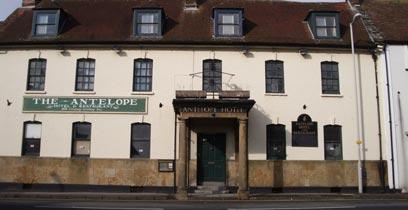
HERE FOR THE BEER: The Antelope and, below, The George Pictures: BARRY BROCK
If you want to learn more, Sherborne Museum publishes a range of local history booklets, including one of mine entitled Sherborne Pub Walks, south of the museum. (Booklets describing walks to the north and east are to follow). Due to be published shortly and not to be missed is Treasures of Sherborne Museum, by Curator Elisabeth Bletsoe. Details of all Sherborne Museum’s publications may be found on sherbornemuseum.co.uk and purchased via Biblio Books, biblio.co.uk.

Mermaid and moved up from South Street in 1929 to take advantage of the new houses being built in the Bristol Road area.
n The George, oldest of them all, old even when Sir Walter Raleigh might have called in for a drink – dating from the 13th century or earlier, although the present building dates from the 16th century.
n The White Hart, which has a name that was moved from a predecessor inn in Castleton in the 18th century but was probably an inn before that. n The Cross Keys, with its spectacular inn sign and striking brick façade, was already in existence in 1756.
n The Eastbury Hotel, the youngest of them and not really a pub, but with a cosy bar, was originally a private house and converted to a hotel in the 1930s.
still ten of them around Sherborne

CHEERS ALL ROUND: The Plume of Feathers and, below, The Cross Keys and The Digby Tap
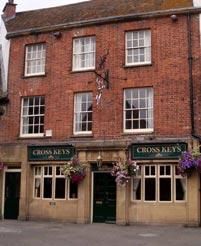
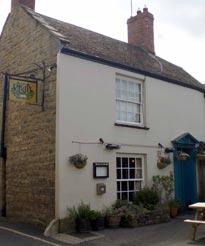
n The Half Moon, substantially rebuilt in the 1930s, and another inn first mentioned in 1756, but older than that – the road outside was named after the inn.
n The Plume of Feathers occupies a building constructed in the late 1600s but could be older (the Plume is named after Henry, Prince of Wales and his badge of ostrich feathers –Henry was Lord of the Manor of Sherborne until his death in 1612).
n The Britannia is a 19th century inn, although the building is older – the southern part was originally a school.
n The Digby Tap, at one time the parish workhouse, was opened in 1870 as an adjunct of the Digby Hotel –still as popular as ever with locals and visitors alike. a stone terrace of houses built for silk workers, thankfully reverted to an earlier name, after being misspelled briefly as the Teddy Rowe; this pub was originally the Traveller’s Rest.
My father was a Sherborne innkeeper and I’ve been collecting information about Sherborne’s pubs and breweries for several years, hopefully for publication in a book I’m provisionally calling Better than Church. The title comes from a quotation by visionary poet and painter, William Blake, who said: “A good local pub has much in common with a church, except that a pub is warmer, and there’s more conversation.” This was true in Blake’s time, and in my own youth, and it is still true now. We can still find the conversation and the warmth, and more than likely the opportunity for a good meal too. But can our pubs survive these present circumstances? Will they still be there when we need them? The covid-19 epidemic with its lockdowns has already closed many pubs and those that are left need our support when restrictions are lifted. Visit any of Sherborne’s pubs and hotels and find yourself immersed in a part of the town’s history. Enjoy a glass of beer and a plate of good food and remember – pubs matter! n If you have personal knowledge of any of Sherborne’s old pubs, whether now closed or still open, and would like to share this with me, then do get in touch with reporter Steve Keenan at sport@ blackmorevale.net who has my contact details.
Roger’s pleased to meet you with
By Karen Bate
newsdesk@blackmorevale.net Butcher Roger Else is still cutting it as he celebrates 60 years in the business, surrounded by friends, family and very loyal customers. The award-winning Else Family Butchers have been firmly embedded in the Stalbridge community since Roger bought the butcher shop when his former boss Michael Cameron retired in 1994. However, Roger’s smiling face has been a familiar sight in the town after he began working for Michael in the butcher shop next door to the Post Office in 1972. With a strong dislike of school, Roger left Sturminster Newton High School at the tender age of 14, when he was told by headmaster Mr Dawes, he could only leave if he had a job to go to. His Uncle Tom told him

MEAT THE TEAM: Roger with his sons and, below, hard at work and, inset, with Brenda

about a butcher’s job available with
Harold Carter in Sturminster in the

premises, which is now the fish and chip shop. No interview was needed and Roger started work a week before Easter 1961. Roger of course was delighted and didn’t bat an eyelid at his 6am starts, riding his bicycle from his Stourton Caundle home and once at work, pedalled the trade bike to the slaughter house at Manston several times a day earning just £2/15 shillings, of which he would give his mum £1, leaving him just £1/15 shillings to save. Eventually Roger was taught how to use a knife and would spend months skinning lambs and deboning pigs’ heads. After 18 months, when he was refused a pay rise of just five shillings a week, he left and joined Mr Jackson at Milborne Port.
meat to please you, for sixty years
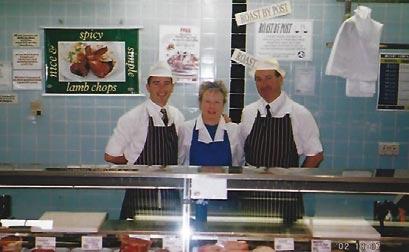
COUNTER ON US: Julian, Brenda and Roger, and, below, a young Roger and, right, the family shop
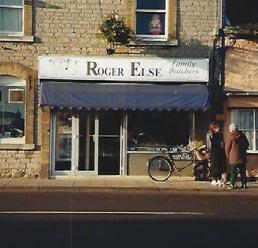
Roger said: “I was able to do more butchery and given the opportunity to learn to drive the delivery van. I remember passing the test without a proper driving lesson. “You could in those days.” After another pay rise refusal, Roger joined Albert Gray in Stalbridge. He was given a new van and delivered meat to all the villages in the area. Romance blossomed on his rounds when Roger met Brenda. The pair fell in love and married in 1968. Julian was born in 1971, followed by Martyn and Nicholas. Roger said: “After two years I joined Michael Cameron, who had just taken ownership of the butcher shop opposite the chemist. “In 1972 Michael bought the house next door to the Post office and opened a butcher’s shop and I continued to work with Michael for 25 years, until he retired.” Julian learned the ropes of butchery at Cameron’s Butchers, where he worked alongside Roger for two years. Julian said: “I would like to thank my dad for all the great years working together, the laughs along the way and the great memories and stories we have made. I very much am looking forward to the years ahead.” After Roger took over the shop, Brenda joined along with Julian and Else Family Butcher’s was born. Roger said: “As a team of eight, we achieved some incredible things. “People would start queuing up on a Thursday and the trade would be remain strong until Saturday lunchtime. “Our displays and personal detail to everything we sold gave us the creditability which is still strong today. “We won an award for being Best Butchers in Dorset three times, and were one of the first to be awarded the Q award for quality. “We received an invitation to HRH The Queen’s Garden Party at Buckingham Palace for service to the public and we were asked to judge the Christmas Fatstock Market in Scotland.” Roger and his wife Heidi took over the shop in 2012 when Roger semi-retired, although he still works two mornings a week and covers holidays. He said: “I’ve been so lucky going to work every single day doing the job I’ve loved. “Over the years I’ve met and made many friends and customers who have all made many memories, the good, the bad and funny, but most of all the shop is my happy place, standing behind the counter selling, chatting and butchering.” Else Family Butchers prides themselves on supplying locally sourced, ethically farmed meat with quality producers and say they ‘wholeheartedly support our local farmers’.










